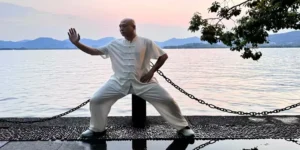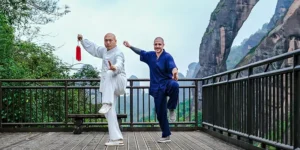Chair Tai Chi, also known as Wheelchair Tai Chi, is a form of exercise that integrates traditional Chinese medicine, Qigong, and Tai Chi and is targeted at patients with lower limb dysfunction and helps disabled patients recover.
In recent years, chair tai chi has been accepted by many with lower limb dysfunction, becoming an exercise and strengthening the body, and is widely used by the disabled. Chair Tai Chi is not only suitable for people with lower limb disabilities but also for the elderly and people who sit for a long time, as well as people who cannot participate in intense exercise due to illness.
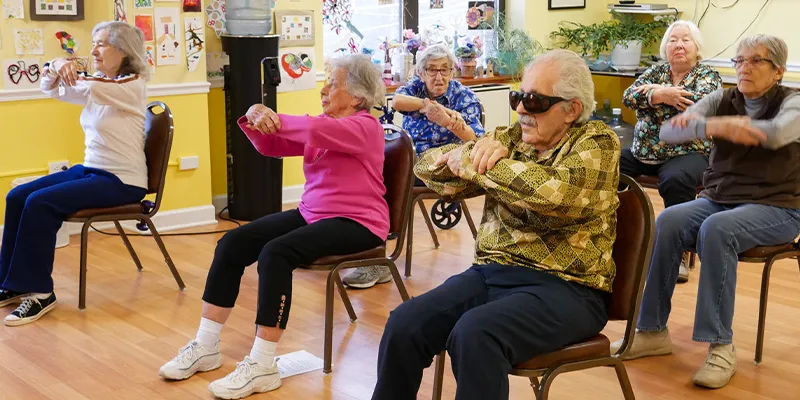
Chair Tai Chi Introduction
At its heart, Chair Tai Chi is seated comfortably and securely in a sturdy chair.
Every action focused on awareness, connecting mind and body. Coordinating slow, deep breaths with movement is fundamental, promoting relaxation and internal energy flow. Tai chi chairs are slow, smooth, and continuous, avoiding jerks or strain. Even while seated, practitioners engage in subtle weight shifts and maintain an upright, aligned spine, mirroring the weight transitions of standing Tai Chi.
Chair tai chi aims to move with relaxed muscles while maintaining a stable, supported core posture provided by the tai chi chair.
The chair tai chi lies in its accessibility. It removes the barriers of balance, leg strength, or joint pain that might prevent someone from practicing standing forms, making the profound benefits of Tai Chi available to a vastly wider audience.
Benefits of Chair Tai Chi
Practicing chair Tai Chi has mental and emotional health benefits:
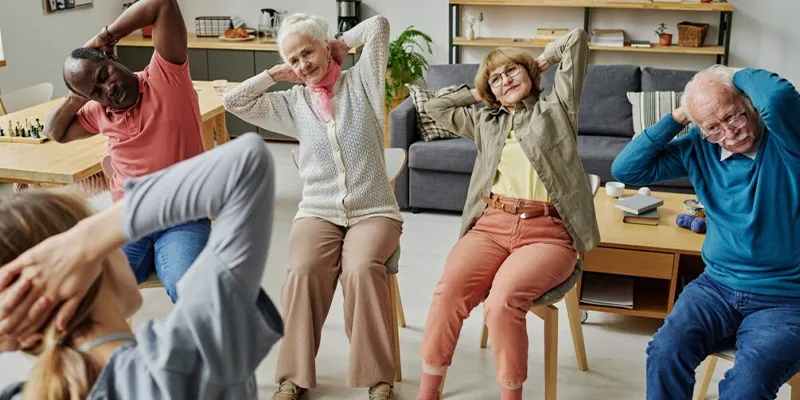
Enhanced Balance and Reduced Fall Risk: The main benefit, especially crucial for seniors. The controlled weight shifts, core engagement, and body awareness practiced in chair Tai Chi directly translate to better stability during daily activities, significantly lowering the risk of falls—a major concern for older adults. Studies show Tai Chi’s effectiveness in senior falls.
Increased Flexibility and Motion: The gentle, flowing movements work through the shoulders, spine, hips, knees, ankles, and wrists, gradually improving flexibility and reducing stiffness, combating the effects of sedentary lifestyles or arthritis.
Improved Strength and Endurance: While low-impact, chair Tai Chi engages core muscles, even while seated, through pressing feet into the floor and subtle leg engagement, arms, and back, building functional strength and muscle over time.
Pain Management: The gentle movement, improved circulation, reduced muscle tension, and stress reduction can help manage chronic pain conditions like arthritis, fibromyalgia, and back pain. The mindfulness practice also helps change the perception of pain.
Stress Reduction: The focus on deep breathing and mindful movement activates the parasympathetic nervous system, lowering stress hormones like cortisol. This promotes deep relaxation, calms the mind, reduces anxiety, and improves overall mood. Regular practice enhances your mental focus and clarity.
Better Cardiovascular Health: Though gentle, the continuous movement and deep breathing improve circulation and can contribute to better heart health and blood pressure regulation.
Enhanced Mind-Body Connection: Chair Tai Chi cultivates a heightened awareness of bodily sensations, breath, and the present moment, fostering a deeper connection between physical and mental.
Why Practice Chair Tai Chi for Seniors
As we age, maintaining physical activity becomes both more critical and potentially more challenging. Chair Tai Chi answers common age-related concerns:
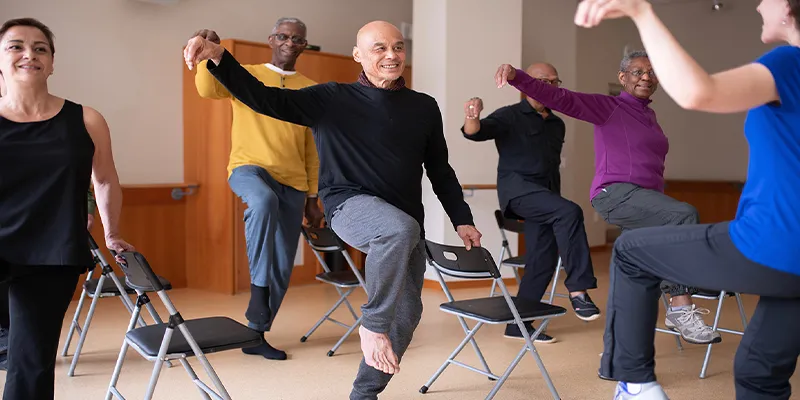
The seated position resolves fall risk during practice, providing a secure foundation. This is necessary for those with osteoporosis, vertigo, or significant balance issues. Chair tai chi places minimal stress on joints, making it suitable for those with arthritis, joint replacements, or chronic pain.
Chair tai chi movements can be easily changed in range and intensity. Someone recovering from surgery or managing significant limitations can benefit just as much as a more active senior.
Learning tai chi forms and coordinating movement with breath provides excellent cognitive stimulation, helping maintain mental sharpness.
Group chair tai chi for seniors classes offers valuable opportunities for socialization, combating isolation and loneliness, while sharing a positive, health-focused activity. It provides a way for seniors to take control their health and well-being, fostering independence.
Organizations like the Mayo Clinic and the CDC recognize the value of low-impact, balance-focused exercises like chair Tai Chi for healthy aging.
Tai Chi Chair Routine
A typical chair Tai Chi session, guided by a qualified instructor, includes a series of gentle exercises and simplified Tai Chi forms adapted for the seated position. Using a stable tai chi chair is essential. Some basic taichi movements often include:
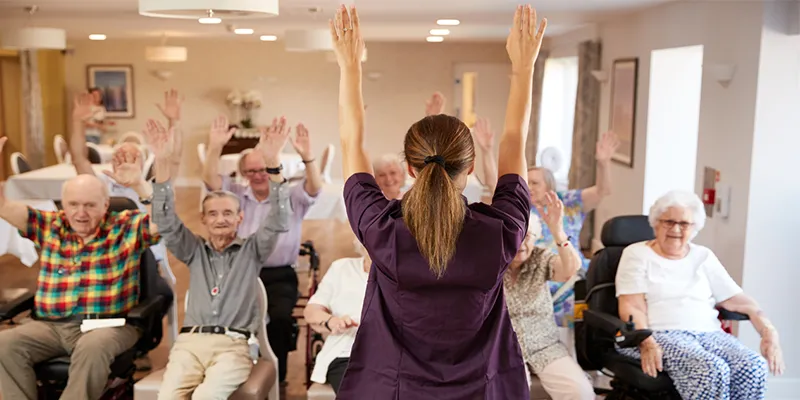
A typical chair Tai Chi session, guided by a qualified instructor, includes a series of gentle exercises and simplified Tai Chi forms adapted for the seated position. Using a stable tai chi chair is essential. Some basic taichi movements often include:
Seated Meditation and Breath Awareness: Beginning with centering, grounding, and focusing on deep abdominal breathing.
Gentle Spinal Rolls and Stretches: Loosening the spine and neck with slow, controlled movements.
Arm Waves: Flowing arm movements across the body, coordinating with breath and gentle torso rotation.
Seated Weight Shifts: Rocking gently forward and back, or side to side, engaging the core and feet.
Arm Circles and Presses: Opening the chest and shoulders, promoting upper body flexibility and strength.
Ankle and Wrist Circles: Maintaining joint mobility in the extremities.
Seated “Brush Knee” or “Parting the Wild Horse’s Mane”: Adapted classic Tai Chi moves, focusing on upper body coordination, turning, and weight shift simulation.
Cool Down: Ending with deep breathing and a sense of calm focus.
The chair tai chi routine is always focused on smoothness, relaxation, and breath coordination, not large ranges of motion or force.
Conclusion
Chair Tai Chi is not just exercise while sitting down. It is a powerful, accessible gateway to holistic well-being. By adapting the wisdom of Tai Chi to the seated position, it reduces stress, improves balance, enhances flexibility, increases strength, and calms the mind.
For seniors seeking safe and effective ways to maintain vitality and independence, chair tai chi for seniors stands out as a remarkably suitable and beneficial practice.
Whether you are managing specific health challenges, looking for gentle movement, or simply seeking a moment of mindful calm in your day, exploring chair Tai Chi with the support of a sturdy Tai Chi chair could be a healthier, more balanced life.

